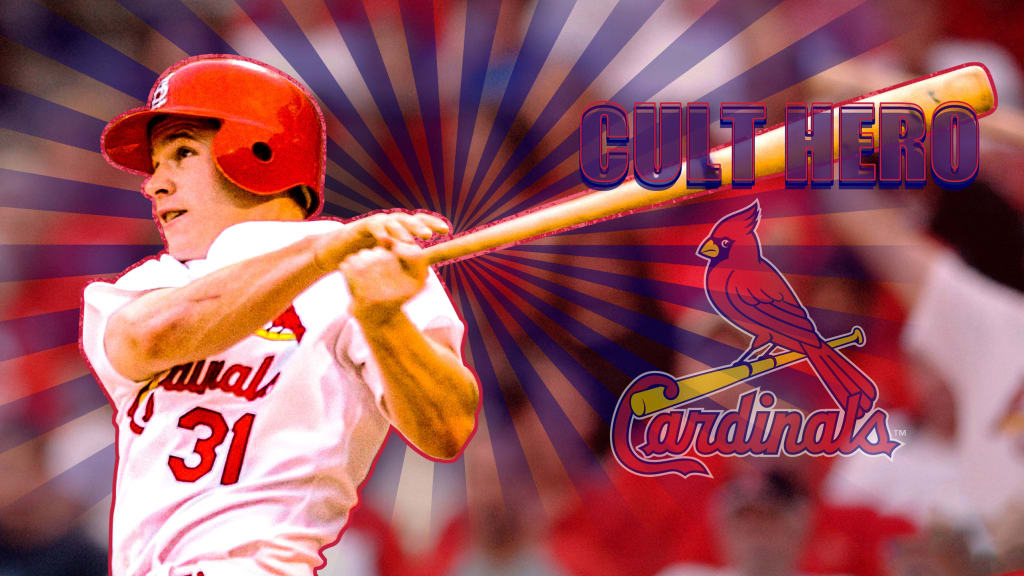
ST. LOUIS -- When Bo Hart lined a pitch into left field for his fourth hit of the Cardinals’ 13-9 win over the Royals on June 28, 2003, Cardinals pitching coach Dave Duncan looked over at bench coach Joe Pettini.
“Well, it’s nice to see Bo break out of his slump,” Pettini remembers Duncan joking.
Hart had gone 0-for-4 the day before, a rare occurrence for the rookie second baseman who tied a 102-year-old Major League record with 28 hits in his first 15 games (.412 average). That record, set by Irv Waldon in 1901, still stands.
After one month in the Majors, Hart was hitting .342/.389/.479.
“I swear I have never seen anything like that in my life,” Pettini said. “Of all the great players we had, I had never seen anyone come up the first month and do what he did. It was amazing.”
Hart is still something of a cult hero in St. Louis. Everyone thought he was a star in the making, and even today, many fans can recall watching Hart burst onto the scene in June 2003.
He finished that season on the Cardinals' roster, but he didn’t make the team out of Spring Training in 2004. His last game in the Majors came on April 29, 2004, a mere 10 months after his debut.
The beginning
The Cardinals selected Hart in the 33rd round of the 1999 MLB Draft out of Gonzaga University. He was a scrappy infielder who played with unrivaled energy, but his odds of making it to the Majors seemed low. That changed in ’03, during Hart’s first season in Triple-A. Cardinals second baseman Miguel Cairo fractured his left hand, and Hart, then 26, got the call to join the team in Milwaukee on June 19.
He made his debut that day and recorded two hits and two RBIs. The only thing he doesn’t remember about his first hit -- a double down the left-field line -- was the pitch count. (It was the third pitch in a 1-1 count.)
“It might have been the third or fourth pitch from the starter, Ruben Quevedo,” Hart said. “It was a ground ball, a chopper down the third-base line, and I was lucky enough for it to scoot past the third baseman. I almost missed first base. Almost ran into [Brewers first baseman] Richie Sexson. Flying around, almost missed it and trotted into second.”
Brewers second baseman Enrique Cruz asked Hart if that was his first hit in his first at-bat. Hart nodded, and Cruz congratulated him.
“It was kind of that moment where I was like, ‘Whoa, I just hit a double in my first at-bat in the big leagues,’” Hart said. “‘Let me take a deep breath and soak this in.’”
Hart didn’t stop with that hit. Instead, he took off flying. The next day, he went 2-for-4. The next, 3-for-5. The first game he didn’t record a hit was his eighth game in the Majors -- the day he went 0-for-4 against the Royals.
“I remember him showing up and being the baserunning guy, I love hustle,” said former Cardinals first-base coach Dave McKay, now with the D-backs. “And this guy was full of that. He came up, and you knew he was going to play hard, run hard, all that. Coaches love those guys. Just happened that this guy went off. He was hitting well, playing well, showed a tremendous amount of confidence.”
Cardinals fans were hooked. A month earlier, they had no idea who Hart was. But by June he was all anyone could talk about. He quickly became a fan favorite for his hustle, scrappiness and production. He received a standing ovation at Busch Stadium in his final at-bat of his third Major League game.
“What I remember is the electricity,” Cardinals broadcaster Dan McLaughlin said. “He was somebody that came from nowhere and ignited that club. Not only ignited the club, but ignited the fan base and the city. It seemed like every time he was on the field, something spectacular -- not just good, but spectacular-- would happen.
“It was like, ‘Who is this guy?’ It was so much fun to watch. That’s what I remember, it was just nuts.”
Hart tipped his cap to the Cardinals faithful that night, but he tried to keep his head down and work as hard as he could to stay in the lineup. His coaches and teammates helped him prepare normally every day, despite their awe at his emergence.
“He was just going up and having some fun, getting hits like that,” McKay said. “It was just a matter of liking this guy’s personality and attitude, liked having him around. Liked watching him play and especially the response of everyone trying to get him out.”
Fans began to wonder what the future would hold for Hart. The Cardinals were trying to keep pace with the Cubs, who won the division, and the Astros that year. Could Hart be the spark plug they needed? Those around the team, and Hart himself, knew that the magic would wear off sometime. Hart just wanted it to keep going as long as possible.
“I mean, he looked like a Joe DiMaggio for a moment,” Pettini said. “But all of a sudden you’re where you want to be at the big league level and you’re having such huge success, it’s tough to keep even-keeled.”
What happened?
Hart continued his hot streak through July and into August, even when Cairo returned from rehab on July 27. Hart hit above .300 until Aug. 7, but by September, his batting average began to dip.
The book was out on how to pitch him -- he began to see more breaking balls and fewer fastballs. He pinch-hit or pinch-ran throughout the final month of the season and ended the year with a .277/.317/.395 slash line and a .713 OPS. The Cardinals finished the season in third place, three games back.
“I always had to fight myself in my career,” Hart said. “I liked to swing early in the count because there were more hittable pitches early in the count. My strategy, especially with not having a lot of information or advanced scouting on me, was to challenge a little more. And, I mean, look at me -- I’m 5-foot-10 and 180 pounds. There’s not a lot of fear by the pitchers as I walked to the plate.
“I was being challenged more early in those first couple of weeks with fastballs because there wasn’t a lot of scouting on me to find a weakness. They found it later.”
Hart worked on adjusting to the breaking balls he was seeing, but his aggressiveness continued. He didn’t walk much, so opponents got him to chase offspeed pitches.
“Guys like him, who are small in stature, come up and pitchers are thinking that they’re going to blow fastballs by them, knock them over,” McKay said. “Then they realize, this guy can catch up to the fastball. The pitchers make adjustments. It’s up to you, then, to make that adjustment.”
Hart went into the offseason feeling like he was on the verge of being an everyday Major League player. He worked out throughout the winter and went into Spring Training looking to compete for a starting spot. Instead, the Cardinals made a late move in spring to acquire Tony Womack, who became the regular second baseman for a team that won 100 games and the National League pennant.
Hart hit .154 in April (2-for-13) and was sent to the Minors on April 30. In 2005, he tried switch-hitting on manager Tony La Russa’s suggestion, but Hart never appeared in another Major League game. He toiled in the Minors with the Rockies, Cubs and Orioles, then spent two years playing independent ball. Hart retired in 2008, at the age of 31.
“Every player always thinks about what could have been,” Pettini said. “But Bo, he was a good player. He got his time in the big leagues, had some success. It’s hard in today’s game with all the video and everything, a lot of kids come up at first and have success, but it becomes a lot tougher than what it was when they didn’t know who you were.”
What now?
Hart, 49, lives in Memphis, works for an information technology company and is the hitting coach for Memphis University School’s high school baseball team. He and his wife, Lydia, have two sons: Cruz, 5, and Brock, 1. Now that Cruz is old enough to understand what baseball is, Hart has begun to share stories from his time with the Cardinals. He and his family made it back to St. Louis for the 2004 reunion at Busch Stadium this year, and as his boys get older, he’ll take them to Triple-A Memphis games.
“I absolutely enjoy it,” Hart said about reminiscing on his brief burst of stardom. “I have great memories, and yeah, there are a lot of what ifs, but those are in the past. I can’t change how I went about my business or how my success or failures paved my career after. I can’t do anything about that. I like sharing about it. It’s a good time of my life.”
His favorite part of being back in St. Louis are when fans tell him their memories of watching him -- of watching history -- in 2003. Fans tell him they remember where they were when he first arrived or when he achieved yet another milestone.
“He’s got a cool chapter of Cardinals history,” McLaughlin said. “And in terms of recent history, he’s a chapter that people will not forget.”
